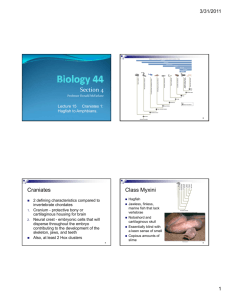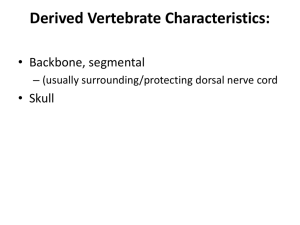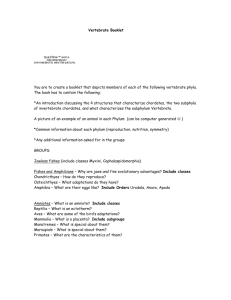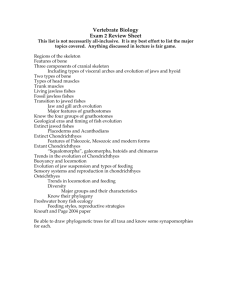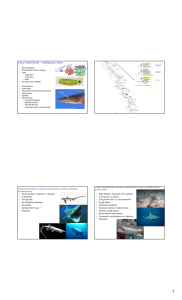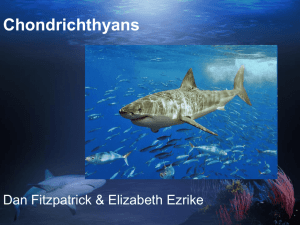Chordata (Fish)
advertisement
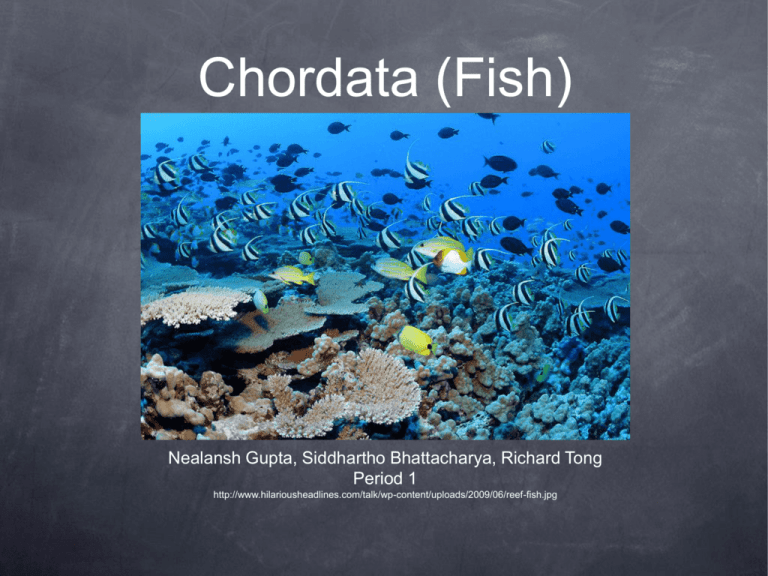
Chordata (Fish) Nealansh Gupta, Siddhartho Bhattacharya, Richard Tong Period 1 http://www.hilariousheadlines.com/talk/wp-content/uploads/2009/06/reef-fish.jpg Siddhartho Bhattacharya Phyla Myxini: jawless Hagfish, snake like Cephalaspidomorphi: Lampreys; oldest living lineage of verabrates. 35 species Chondrichthyes: Sharks, rays, etc. The biggest and most successful predators Actinopterygii: Ray-finned fishes; common fishes: bass, clownfish, tuna, etc. Actinistia: Lobed fin, spike containing fish Dipnoi: Lungfish, freshwater Nealansh Gupta Examples Myxini (hagfish) http://en.wikipedia.org/wiki/File:Pacific_hagfish_Myxine.jpg Cephalaspidomorphi) (Lamprey) http://en.wikipedia.org/wiki/File:Diversas_lampreas.1__Aquarium_Finisterrae.JPG Chondrichthyes (Shark) http://en.wikipedia.org/wiki/File:White_shark.jpg Actinopterygii (regular fish) http://z.about.com/d/animals/1/G/s/Q/fishes.jpg Actinistia (coelacanths) http://en.wikipedia.org/wiki/File:Latimeria_Chalumnae__Coelacanth_-_NHMW.jpg Dipnoi (South American Lungfish) http://en.wikipedia.org/wiki/File:Lepidosiren_paradoxa_0.jpg Richard Tong Body Cavity All contain a coelom (fluid filled space separating digestive tract from the outer body wall; tissue usually derived from the mesoderm. Nealansh Gupta Body Symmetry All fish are bilateral (mirror image halves) Myxini and Cephalaspidomorphi also contain radial symmetry (symmetry radiating along the center) Siddhartho Bhattacharya Nervous System All are cephalized with brains Myxini: contain 2 brains. Lack a SNS. Contain free nerves throughout skin. Cephalaspidomorphi: Complete CNS. Chondrichthyes: Simple brain, simple column, simple network of nerves. Actinopterygii: complete CNS Actinistia: CNS Dipnoi: CNS Circulatory System Richard Tong ALL HAVE CLOSED CIRCULATORY SYSTEMS Myxini: primitive circulatory sytem with 4 hearts, one is brachial and serves as main pump while the other 3 serve as accessory pumps. Cephalaspidomorphi: two chambered heart. Chondrichthyans: two chambered heart. RBC created not in bone marrow but in the spleen and special tissue around gonads. Actinoterygii: two chambered heart. No separation of oxygenated and deoxygenated blood. Actinistia: two chambered heart. Dipnoi: partial four chambered heart. Separation of oxygenated and deoxygenated blood Nealansh Gupta Digestive System All ingest through the mouth Myxini: Eat dead things from the inside out. Food in gut is enclosed in an impermeable membrane. Cephalaspidomorphi: Use teeth to get through skin to suck blood. Gut is their stomach. Chondrichthyes: Short digestive tract with a spinal valve within shark intestine to increase SA and prolong food passaging. Actinopterygii, Actinistia, Dipnoi: Breakdown in esophagus. food digested in stomach and processed in finger shape pouches, secrete enzymes and absorb nutrients. Intestine completes process. Richard Tong Excretory System All fish excrete through anus. All have kidneys Myxini, Cephalaspidomorphi: Have 2 kidneys. Only use their mesonephric kidney (do not use the other one) Chondrichthyes: Sharks urinate through penis. Actinopterygii, Actinistia, Dipnoi: Contain a urinary bladder. Siddhartho Bhattacharya Locomotion/Musculature Musculature: All contain a complex muscle system similar to that of humans Myxini: swim in snakelike fashion by using their segmented muscles to exert force on their notochord Cephalaspidomorphi: they use an anguilliform (movement by snaking body through water) similar to myxini, but laterally direct a wave along body. Have the ability to swim backwards. Chondrichthyans: contain fins for movement; shark like chondrichthyans contain a heterocercal tail for locomotion and rays contain flexible pectoral fins Actinoterygii and Actinistia: anterior to posterior sequential contractions along one side of the body with simultaneous relaxation along other side. Actinistia also use fins. Dipnoi: contain small leg-like appendages to move over rocks and mud and all other surface obstacles. Nealansh Gupta Skeletal Type Myxini have no vertebrae but notochord (strong flexible rod of cartilage); all other phyla contain a vertebrae Myxini, Cephalaspidomorphi, and Chondrichthyans contain cartilage skeletons (Chondrichthyans have calcium cartilage) Actinoterygii, Actinistia, and Dipnoi have bone skeletons. Actinoterygii: fins supported by flexible bone rays Actinistia and Dipnoi: fins supported by rod shaped bones and spikes Siddhartho Bhattacharya Sensory Structures/Features All have lateral lines (detects motion/vibration in water) Myxini: 2 simple eyespots. No eye muscle. Single nostril. 6-8 barbels (whiskerlike tactile sensory organ near mouth) Cephalaspidomorphi: 2 large eyes. one nostril on top of head Chondrichthyes: Keen smell. 2 complex eyes (contract/dilate). 2 nostrils. May have sharp hearing. Electroreception. Actinopterygii, Actinistia, Dipnoi: 2 complex eyes. Inner ears. Smell. two nostrils. Reproduction Nealansh Gupta All are sexual reproduction. All external fertilizers (oviparous) except sharks. All have testes and ovaries. Myxini: Some are hermaphroditic (but only one gamete functions) no larva stage Cephalaspidomorphi: Larva stage Chondrichthyes: Internal fertilization. Fetus can grow inside female, can be in egg outside body, maintain a placental link. Richard Tong Gas Exchange All have gills, allow for oxygen carbon dioxide exchange through capillary network. Water pumped over gills pushing oxygen poor water out and pulling in oxygen rich water through mouths. Myxini, Cephalaspidomorphi, Chondrichthyes: contain multiple gill openings Dipnoi: Have paired lungs; must surface to gulp air. Some are obligate air breathers (must breathe air periodically) Siddhartho Bhattacharya Other Myxini: Produce slime to escape capture and distract predators. Cephalaspidomorphi: Attack prey by attaching mouths to animal and use teeth to cut through skin and scales to suck blood. Chondrichthyes: sharks jaw is not attached to its cranium. It has a layer of tiny hexagonal plates which give some strength. Actinopterygii: comprises of nearly 95% of the 25,000 species of fish Actinistia: Have a symmetrical tail Dipnoi: Contain little legs for movement Richard Tong QUIZ QUESTIONS! WHAT PHYLUM DOES NOT HAVE A VERTEBRAE?A. ChondrichthyesB. MyxiniC. ActinistiaD. Dipnoi MYXINI Which Phylum is a coelomate? A. Porifera B. Cnidaria C. Chordata (fish) D. Platyhelminthes Chordata (fish) WHICH CONTAIN A CEPHALIZED NERVOUS SYSTEM? A. Chondrichthyes B. Myxini C. Actinistia D. All All True or False: All Chordata (fish) contain lateral lines TRUE THE END http://www.tudiscovery.com/tiburones/que_es/popup_que/asset/07914907646434433_elephant_shark_380x290.jpg http://blog.rocketboom.com/post/102948092/the-top-15-most-bizarre-sea-animals
